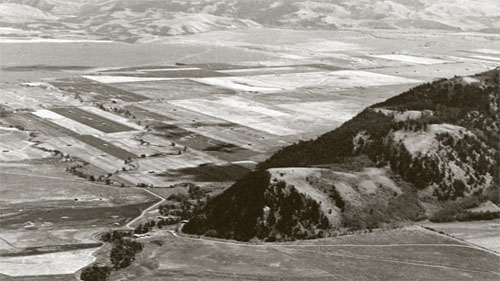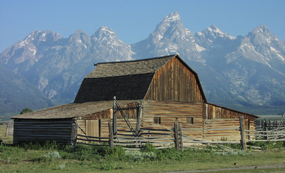For those of you who do not know where Mormon Row is, if you drive north from Jackson on highway 191 past Moose Junction and turn right onto Antelope Flats Road, you can follow the road about 1 ½ miles until you see a north-south running dirt road marked by a distinctive pink stucco house on the left with a small dirt parking area.
Mormon Row may be one the most picturesque areas of Grand Teton National Park. The groups of old farm buildings have rustic, wooden buildings surrounded by open fields, grass and sage standing out against the stunning backdrop of the Tetons. This historic place is a great way for seeing into the lives of the West’s early settlers and can be commonly seen with grazing wildlife right up to the walls of the original structures. A great place to find bison, antelope, moose, coyotes, ground squirrels, northern harriers, kestrels and sage grouse.
Here is the back story: The leaders of The Church of Jesus Christ of Latter-day Saints, or Mormons, sent parties from the Salt Lake Valley to establish new communities and support their expanding population. Arriving in the 1890s from Idaho, these old farm buildings have withstood the elements for more than a century, since the farmland here was first homesteaded by the predominantly Mormon settlers in the early 1900s. The Mormon homesteaders, settled east of Blacktail Butte and clustered their farms to share labor and community, a stark contrast with the isolation typical of many western homesteads.
These settlers established 27 homesteads in the Grovont area because of relatively fertile soil, shelter from winds by Blacktail Butte and access to the Gros Ventre River. Despite the harsh conditions of Jackson Hole, Mormon settlers grew crops by using irrigation. These hardy settlers dug ditches by hand and with teams of horses, building an intricate network of levees and dikes to funnel water from central ditches to their fields between 1896 and 1937. Water still flows in some of these ditches.
After the Rockefellers Snake River Land Company bought the majority of the land and transferred it to the Park Service, the buildings were allowed to decay until the 1990s, when their cultural value was recognized and steps were taken to preserve them. Today, six homesteads and a single ruin provide visitors a glimpse into the past of Jackson Hole Valley.
 |
| Aerial photo of Blacktail Butte and Mormon Row Courtesy of Jackson Hole Historical Society and Museum, 1991.3991.001 http://www.nps.gov/grte/historyculture/mormon.htm |
 |
| John Moulton Barn Courtesy of Jackson Hole Historical Society and Museum, 1991.3991.001 http://www.nps.gov/grte/historyculture/mormon.htm |
 |
| Andy Chamber's Residence |
The most extensive historic complex remaining on Mormon Row is the Andy
Chambers homestead. Andy Chambers claimed land in 1912 and secured the
title under the Homestead Act by building a log cabin and stable and
clearing ground to grow grain, a backbreaking chore in the rocky soil.
The family lacked running water until 1927 and harnessed electricity
with a windmill in 1946. The Rural Electric Administration did not
provide power to Mormon Row until the 1950s. By this time, many families
had sold their homesteads to become part of the park. The windmill
still stands on the homestead.
Of course, it would not be complete without seeing some wildlife tracks! I suspect we have coyote wandering the area! However, we did not see any, the tracks looked pretty fresh and were probably there earlier that morning before we arrived to Mormon Row.
 |
| Coyote Tracks |
 |
| Almost the Size of My Palm |
TheChristyBel
No comments:
Post a Comment